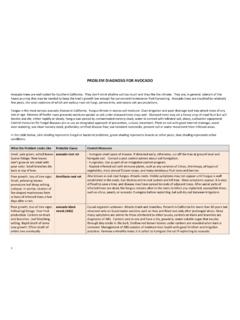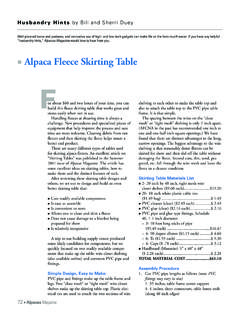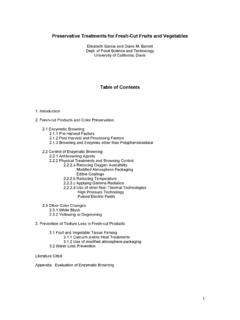Transcription of HANDLING OF CUT FLOWERS FOR EXPORT - …
1 HANDLING OF CUT FLOWERS FOR EXPORT Reid University of California, Davis, CA, 95616, table of Contents I. WHAT ARE ORNAMENTALS? .. 3 II. QUALITY LOSS IN ORNAMENTALS .. 3 GROWTH, DEVELOPMENT, AND AGING .. 3 FLOWER SENESCENCE .. 4 WILTING .. 4 LEAF YELLOWING AND SENESCENCE .. 4 SHATTERING .. 4 III. FACTORS AFFECTING POSTHARVEST QUALITY .. 4 FLOWER MATURITY.. 4 TEMPERATURE.. 5 FOOD SUPPLY.. 7 LIGHT.. 8 WATER SUPPLY.. 8 WATER QUALITY.. 9 ETHYLENE.. 10 GROWTH TROPISMS.. 10 MECHANICAL DAMAGE.. 11 DISEASE.. 11 Proflora bulletin 2009 - 2 -IV. POSTHARVEST MANAGEMENT TECHNIQUES .. 11 HARVESTING.. 12 GRADING.. 12 BUNCHING.. 12 CHEMICAL SOLUTIONS.. 13 Rehydration.. 13 Pulsing.. 13 Bud Opening.. 14 PACKING.. 14 Box design and construction .. 15 Packing systems .. 16 COOLING .. 17 Cooling Time Calculations .. 17 Fans .. 18 Tropical FLOWERS .. 19 Cooling for aquapacks .. 20 Vacuum cooling .. 20 IRRADIATION .. 21 V. QUALITY CONTROL.
2 21 VI. LOGISTICS FOR AIR TRANSPORT OF CUT FLOWERS .. 22 TEMPERATURE MANAGEMENT BEFORE LOADING .. 23 PALLET CONSTRUCTION .. 23 VII. USEFUL REFERENCES AND SUGGESTED FURTHER READING .. 23 VIII. 25 IX. INDEX .. 25 In the past thirty years, the market for cut FLOWERS has become a global one; FLOWERS and cut foliage sourced from throughout the world are sold as bunches or combined into arrangements and bouquets in the major target markets, such as North America, Japan, and the EU. The high EXPORT value of cut FLOWERS has led to dramatic increases in production in many countries, and particularly Colombia. Production of cut FLOWERS and foliage can be highly profitable in countries with an ideal growing environment (particularly those close to the equator where the environment is uniform throughout the year), and low labor costs. The costs of establishing production in the field or even in plastic houses are relatively modest, and harvest may start within a few months of planting.
3 Because of this global production system and marketplace, and the high perishability of cut FLOWERS , air transport has been the transport system of choice. The purpose of this bulletin is to provide information on the factors that affect the postharvest life of cut FLOWERS and foliage, to indicate critical control points in the EXPORT logistics that impact the life of these delicate products, and to suggest best practices for ensuring optimal out-turns during marketing. Concise, practical guidelines for shippers HANDLING cut FLOWERS by air are needed to ensure an industry-wide standard of excellence. Industry analysts stress the - 3 - importance of quality and reliability in the increasingly competitive global market for cut FLOWERS . The most important aspect of quality is freshness and vase life, and these aspects depend on optimum postharvest HANDLING .
4 The first section of this bulletin reviews the most important factors affecting postharvest quality of cut FLOWERS and other ornamentals. The second section outlines standard techniques applicable to the commercial HANDLING of most cut FLOWERS , and includes suggestions for improving present postharvest HANDLING . The guidelines rely largely on research that has been published in the scientific literature on optimum HANDLING methods for cut FLOWERS . We are indebted to Dr George Staby, Perishables Research Organization, Pioneer, Calif., for the use of his computerized database of references on the care and HANDLING of cut FLOWERS . His website ( ) provides an excellent reference for more detailed information on HANDLING systems for individual crops, as well as the general techniques described in this bulletin. I. WHAT ARE ORNAMENTALS? A wide variety of plant materials are grown and harvested for their ornamental value including ferns and lycopodiums, gymnosperms (pines, firs, podocarps etc.)
5 , and angiosperms (the flowering plants). The products that we think of as ornamentals include those that are cut for their FLOWERS and/or foliage, and those that are sold as potted flowering plants or potted foliage plants. Dormant ornamental nursery plants and propagules, including rooted and unrooted cuttings, bulbs, corms, tubers, and rhizomes also are important perishable crops and require quite specific HANDLING . Because the preponderance of ornamentals produced in Colombia are cut FLOWERS , these are the major focus of this bulletin, but the principles outlined here apply equally to cut foliage, potted plants, and rooted and unrooted cuttings. II. QUALITY LOSS IN ORNAMENTALS Whether cut or intact, ornamentals are complex plant organs, in which loss of quality of stems, leaves, or flower parts may result in rejection in the marketplace. In some ornamentals loss of quality may result from one of several causes, including wilting or abscission of leaves and/or petals, yellowing of leaves, and geotropic or phototropic bending of scapes and stems.
6 In thinking about factors that affect the life of ornamentals and how to extend that life, it's important first to understand the diverse causes of quality loss. Growth, development, and aging In plants, death of individual organs, and of the whole plant itself, is an integral part of the life cycle. Even in the absence of senescence of floral organs or leaves, the continuing growth process can result in quality loss, for example in spike-type FLOWERS that bend in response to gravity. Proflora bulletin 2009 - 4 - Flower senescence The early death of FLOWERS is a common cause of quality loss and reduced vase life for cut FLOWERS . FLOWERS can be divided into several categories in terms of their senescence. Some FLOWERS are extremely long-lived, especially in the daisy and orchid families. Others are short-lived, including many of the bulb crops, like tulip, Iris, and Narcissus.
7 Wilting Extended life for cut and potted ornamentals depends absolutely on a continuing and adequate supply of water. Failure of water supply, whether through obstruction of the cut stems, or through inadequate watering of pots, results in rapid wilting of shoot tips, leaves, and petals. Leaf yellowing and senescence Yellowing of leaves and even of other organs (buds, stems) commonly is associated with the end of display life in some cut FLOWERS (alstroemeria and lilies being an important example). Leaf yellowing is a complex process that may be caused by a range of different environmental factors. Shattering Loss of leaves, buds, petals, FLOWERS , or even branchlets, a process called 'shattering', or 'abscission', is also a common problem in cut FLOWERS . Very often, this problem is associated with presence of ethylene in the air, but other environmental factors may also be involved.
8 III. FACTORS AFFECTING POSTHARVEST QUALITY Maintaining quality in EXPORT cut FLOWERS depends on an understanding the factors that lead to deterioration. Understanding these factors allows the grower and shipper to develop and implement optimum postharvest HANDLING technologies. Flower Maturity. Minimum harvest maturity for a cut-flower crop is the stage at which harvested buds can be opened fully and have satisfactory display life after distribution. Many FLOWERS are best cut in the bud stage and opened after storage, transport or distribution. This technique has many advantages, including reduced growing time for single-harvest crops, increased product packing density, simplified temperature management, reduced susceptibility to mechanical damage and reduced desiccation. Many FLOWERS are presently harvested when the buds are starting to open (rose, gladiolus), although others are normally fully open or nearly so (chrysanthemum, carnation).
9 FLOWERS for local markets are generally harvested much more open than those intended for storage and/or long-distance transport. - 5 - Temperature. Respiration of cut FLOWERS , an integral part of growth and aging, generates heat as a by-product. Furthermore, as the ambient temperature rises, the respiration rate increases. For example, a flower held at 30oC is likely to respire (and therefore age) up to 45 times as fast as a flower held at 2oC. The rate of aging can be reduced dramatically by cooling the FLOWERS . Rapid cooling and maintenance of the cool chain are thus essential for maintaining quality and satisfactory vase life of cut FLOWERS . Although air transport is rapid compared to surface modes (truck, sea container, etc.)
10 , the response of cut FLOWERS and foliage to temperature leads to their rapid deterioration even during the relatively few hours that they are in transit when transported by air. It has frequently been demonstrated that transport of FLOWERS in surface modes that permit maintenance of the cold chain results in better out-turns than air freight under uncontrolled temperatures. This is largely a result of the dramatic response of FLOWERS to increased temperatures. For this reason, air transport is seldom the method of choice when alternative transportation modes that offer good control of temperature are available. An important goal of this bulletin is to sensitize those involved in EXPORT of FLOWERS to the importance of the cool chain to flower quality, and to suggest strategies to improve temperature control during air transport. The accompanying photographs demonstrate the effect of storage for four days at different temperatures on the subsequent quality and vase life of some common cut FLOWERS .
















